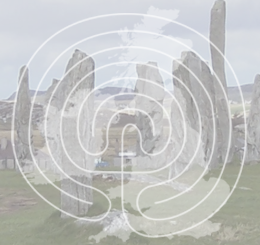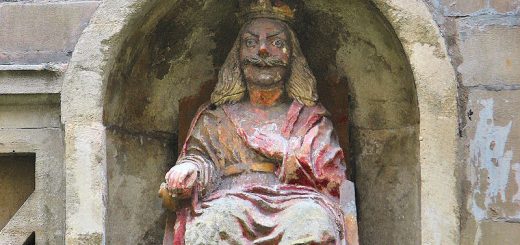Wallace’s Heel Well, Ayr
Wallace’s Heel is a natural spring on the banks of the river Ayr associated with the legendary exploits of William Wallace. Many of the stories surrounding William Wallace originate from a poet/minstrel known as ‘Blind Harry’ who authored a book around 1477 outlining his heroic deeds. Written over 170 years after his gruesome execution, historians regard them as more legend than historical fact. The stories would probably have been gathered from tales circulating by word of mouth at the time and from a quoted source book that has never been discovered. However whatever the truth in the stories, Wallace is towering figure in the vein of other legendary heroes with a definite historical precedent.
 The legendary origin of the well dates from when Wallace had had an altercation with some English soldiers, either on the banks of the river or in the town of Ayr. Wallace had essentially given the soldiers a bit of a thrashing, breaking the back of one of the soldiers in a combative, staff wielding version of the slapsies. Fleeing a larger number of the soldiers and hounds on his trail Wallace jumped down from the path onto the banks of the river Ayr. Landing with such force that his heel split the rock, ushering out a stream of pure water and leaving the imprint of his heel to the present day. Wallace escaped across the river to his waiting horse and remained on the run as an outlaw, returning (in some versions) with his men to dig out the well further as a supply of fresh water for his refuge in the nearby woodland.
The legendary origin of the well dates from when Wallace had had an altercation with some English soldiers, either on the banks of the river or in the town of Ayr. Wallace had essentially given the soldiers a bit of a thrashing, breaking the back of one of the soldiers in a combative, staff wielding version of the slapsies. Fleeing a larger number of the soldiers and hounds on his trail Wallace jumped down from the path onto the banks of the river Ayr. Landing with such force that his heel split the rock, ushering out a stream of pure water and leaving the imprint of his heel to the present day. Wallace escaped across the river to his waiting horse and remained on the run as an outlaw, returning (in some versions) with his men to dig out the well further as a supply of fresh water for his refuge in the nearby woodland.
The actual site is on the official River Ayr Way accessed by steps that lead down to the slight hollow beside a drystone wall where the well is situated. A plaque bearing the text ‘Wallace’s Heel’ is the only indication that this is a site of historical/folkloric importance and would be easy to miss otherwise, as focal attention is drawn a short distance down the path to the 18th century limekilns which look for all purposes like the remains of a ruined castle.
 The water, which is cold enough to numb the hand, flows at a steady rate from a slightly larger than fist sized hole in the sandstone, in a wider depression which may be the heel of legend although it’s more the size and shape of a dinosaur track. There are a few anomalies: The actual hole the water comes out for from the depression in the sandstone is very smooth like it has been drilled at some point – oddly enough there is a depression in the sandstone which looks much more the size and shape of a heel closer to the river, although no flowing water issues from this. The inside of this feels much more irregular and natural. It’s certainly a site that could benefit from more research into its past. To me the heel imprint is more likely to be the one that is not (currently?) the source of the spring water. Linked perhaps with the story that he came back to dig the well out – it also looks more likely as a possible petrosomatoglyph than the water source?
The water, which is cold enough to numb the hand, flows at a steady rate from a slightly larger than fist sized hole in the sandstone, in a wider depression which may be the heel of legend although it’s more the size and shape of a dinosaur track. There are a few anomalies: The actual hole the water comes out for from the depression in the sandstone is very smooth like it has been drilled at some point – oddly enough there is a depression in the sandstone which looks much more the size and shape of a heel closer to the river, although no flowing water issues from this. The inside of this feels much more irregular and natural. It’s certainly a site that could benefit from more research into its past. To me the heel imprint is more likely to be the one that is not (currently?) the source of the spring water. Linked perhaps with the story that he came back to dig the well out – it also looks more likely as a possible petrosomatoglyph than the water source?
The site was known in Victorian times as it appears on old postcards. There was also a ladle placed by the well so that the water could be tasted, so there may have been a belief in its healing properties. It is difficult to ascertain if this was a site that was venerated in the far past – or when the story of its association with Wallace came about. Perhaps the Wallace legend is a later version of another legendary hero/spirit/god from pre historic times, but this is obviously pure speculation.
Unfortunately the river here at the time has been marred by the dumping of a number of plastic bins and office chairs: a metaphor for a wider global rot perhaps. It’s a situation that is not unusual and I generally take a bag to any site I visit these days solely to take away other peoples discarded shit. My favourite so far was the broken wine bottle and plastic wine glasses unceremoniously stuffed under a tree on top of Loudoun Hill, but that’s a site and a story for another day. I suppose it plays out into the wider mythology of the wounded land.
By Daniel Parkinson



Recent Comments